
|
|
|
|
 |
|
Home Site Search Contact Us Subscribe
|
|
|
|
Tradition and Innovation in Sustainable Design: EHDD Architecture
Joseph Esherick's legacy of research and technical considerations that can inspire design continues. by Ron Nyren July 21, 2003 Sustainable strategies are often
considered an innovation of the 21st century. But the history of
sustainability reaches back to pre-industrial building types such as tents,
igloos, and icehouses, which control their interior climates through simple
means and respond to a specific climate and site. Only with the industrial age
did buildings become isolated from their environment, using mechanical and
electrical means to control ventilation, temperature, and lighting, and relying
on manmade building materials not always best for the environment. By understanding that sustainable
issues are part of a long tradition of people’s efforts to live comfortably in harmony
with their environment, designers can consider the challenges a source of
inspiration. No matter the environmental constraints, a designer must apply
known techniques to a great unknown – how can this design best respond to a
specific program, a specific site, a specific climate? The California
Bay Area has a longstanding tradition of design that responds to and integrates
with the particular climate of the region. Joseph Esherick, FAIA, who founded San
Francisco-based Esherick Homsey Dodge & Davis (EHDD) in 1946, was one of
the best-known architects of the Bay Region tradition. Esherick favored an
economy of means, and believed that architecture should be a clear expression
of tangible issues. A love for research, and for allowing technical considerations
to inspire designs, has been a core element of the firm’s philosophy from the
start. As early as the 1950s, the office performed sunshading and daylighting
studies on all projects, using the results to shape the design. The Sea Ranch
projects in the 1960s are classic examples – the designs grew out of detailed
climate studies, wind tunnel studies, interviews with residents, and building
science research. Sustainable design has become
more high-profile in recent years because of a new urgency about environmental
issues, as well as technological advances that offer architects a wider range
of techniques to address them. Designers have become more aware of how
buildings contribute to environmental problems, including the release of carbon
dioxide and its impact on global warming. Using energy and water resources more
efficiently has become more important. Five recently completed and forthcoming
projects show EHDD extending Esherick’s legacy, combining both long-established
and innovative ways of creating sustainable architecture. Global Ecology Center: Addressing
Climate Change Sustainable
design techniques were a natural choice for the Carnegie Institution of
Washington’s new Global Ecology Center on the Stanford University campus. The
Institution created the Department of Global Ecology in 2002 to increase
understanding of the earth’s large-scale ecological processes, including
climate change. The 12,000-square-foot facility, slated for completion this
December, includes laboratory, office, and greenhouse space. The Carnegie
Institution sought a design that would dramatically reduce carbon dioxide
emissions, a major contributor to climate change. Energy use
over the lifetime of a building is responsible for the most carbon dioxide
emissions. To reduce energy use, the offices are naturally ventilated. To
improve comfort, the design makes use of a compressor-less cooling method, an
innovative night spray sky system designed by Rumsey Engineers and the Davis
Energy Group. Late at night, sprinklers cover the roof with a thin film of
water. Radiant cooling rapidly chills the water, especially on the clear nights
that follow the region’s hottest days. This water is piped into a thermal
storage tank. During the day, the chilled water travels through radiant tubing
in the concrete slab throughout the building, and supplies the fan coil units
to cool the 100 percent outside air in the laboratories. To
enhance collaboration among scientists, laboratory doors open onto a central
lobby for informal gathering. A cool tower connected to the lobby uses natural
forces to make the space comfortable on hot days. “The cool tower is an ancient
technology, from Middle Eastern desert climates,” observes Scott Shell, AIA, a
senior associate at EHDD. “It’s just starting to be used in the West.” The
height of the tower catches the stronger prevailing breezes 35 feet off the
ground and directs them down into the space. Misters at the top of the tower
evaporate water into this air stream, cooling the air up to 15 degrees. The
building’s total energy consumption is estimated to be 50 percent lower than
required by California’s strict new energy code. To further reduce carbon dioxide
emissions on this project, more than half of the cement in the concrete is
replaced with fly ash, a waste product from coal-burning power plants.
Manufacturing cement releases eight percent of all global greenhouse gases,
according to Shell. EHDD has pioneered high fly ash concrete that cuts this
amount in half. The fly-ash concrete will be tested to see if its dramatically
lower permeability will reduce the need for expensive floor sealers below
impervious floor coverings. Factor
10 House: Affordable Green Design in a Single-Family Home
A
grass roof that promotes cooling and insulation and a wall lined with bottled
water are among the innovative strategies of EHDD’s Factor 10 House, an
affordable, energy-efficient, single-family residence currently under
construction in Chicago. The house was one of five entries selected from a
field of 73 to be built in an international competition held by the city. The
design seeks to reduce environmental impact by a factor of 10 compared to the
average American home. Designed by EHDD’s Chicago
office, Factor 10’s 1,200-square-foot modular design and open plan is
intersected by a solar chimney, topped with a clerestory window. The
south-facing window controls light carefully, bringing daylight to the core of
the house, and reducing the need for artificial lighting. A whole-house fan in
the chimney pulls warm air up and out of the house in the summer, and pushes
warmed air down in winter. Maximum insulation and careful placement of the
windows further reduce energy consumption. “The home is designed to reduce
energy consumption in a holistic way,” says EHDD Principal Marc L’Italien, AIA.
“We incorporated four strategies – reducing size, improving efficiency,
extending life span, and reducing impact – to meet the project’s ambitious
program goals.” Materials were selected for their
extended life spans and low-impact initial production. The design incorporates
recycled materials in a variety of ways, the most notable of which is a wall of
recycled water bottles filled with City of Chicago water that serves as a heat
sink in the solar chimney. Porches have metal awnings, further enhancing the
house’s energy efficiency. The grass roof
counters the effects of heat gain through evaporative cooling, thereby reducing
energy consumption. It also extends the roofing membrane’s life span by blocking
destructive UV rays; reduces the impact on the city sewer system by absorbing
and retaining storm water runoff; and converts carbon dioxide to oxygen, all
while looking beautiful. The
home also uses high fly ash concrete, and includes a wraparound deck
constructed from Ipé, a certified Brazilian hardwood that naturally resists
rot, decay, insects, and mold without using toxic chemicals, unlike other
decking products. UC Merced Science and Engineering Building: High-Tech Systems Save
Energy
As the newest
campus of the University of California system, and among the first major
research institutions to be built in the 21st century, UC Merced is
committed to being a model of sustainable design. The Science and Engineering
Building is one of the campus’s first three buildings. In
collaboration with Arup Engineers and the California Institute of Energy
Efficiency, EHDD developed a design that exceeds California’s strict new Title
24 energy code by 30 percent. Laboratories
in general tend to use four times as much energy as a typical university
building, since codes require 100 percent outside air and high ventilation
rates. And in the hot California Central Valley, keeping cool can be a huge
energy drain. For these reasons, the mechanical system offered the most
opportunities for reducing energy use. The
central plant has a thermal energy storage tank so chilled water can be
produced at night, when electrical demand is low. This chilled water is
supplied to air handlers in the laboratory building for cooling the building
and process equipment. A careful selection of filters and coils, and generous
duct sizes that allow use of smaller fans, also save energy. Accurately
estimating the internal heat load from the lab equipment avoided excess air
conditioning capacity. Fume
hoods use variable air volume controls to minimize exhaust rates. Office and
conference rooms are separated from the labs so they can have operable windows
and natural ventilation. EHDD
also developed a three-story arcade with glass sunshades to shield the
southeast and southwest façades. The 170,000-square-foot building is scheduled
to open at the end of 2004. Audubon Society Interpretive Center: Platinum Rating for Off-the-Grid Education When
completed at the end of this year, the 5,000-square-foot Audubon Society
Interpretive Center in Los Angeles will bring ecology education to inner-city
youth. The building is expected to achieve a LEED (Leadership
in Energy and Environmental Design) platinum rating. Because it is located
hundreds of yards from site utilities, bringing utilities onsite would have
been a major expense; the money was better-spent creating self-sustaining
systems, allowing the facility to be “off the grid.” Photovoltaic
panels provide all electricity. The key to using photovoltaics without spending
a fortune is to inventory all electrical loads and significantly reduce the
demand. The inventory for the Audubon Society identified several large energy
users, including a vending machine and a pump on the courtyard fountain. No
efficient vending machines could be found, so this feature was eliminated. A
redesigned fountain and pump reduced energy requirements from 100 kWh per day
to 7 kWh per day in the winter. The building’s overall electrical demand was
reduced to 50 kWh per day, 60 percent better than required by Title 24. The
Interpretive Center includes one large conference/classroom that is frequently
used for large groups and late afternoon board meetings. Mechanical cooling
proved necessary for this space. Using an absorption chiller driven by solar
hot water panels avoided a significant increase in photovoltaics. All
wastewater is treated in a biological treatment system. During the first year, water
reclaimed through the treatment system will be used only for subsurface
irrigation. The county will monitor the purity of the water, and if it meets
the standards expected, it will then supply toilets. Dual-flush toilets and
waterless urinals further reduce water use. Ross School: The Power of Passive Cooling
The program
for the new Ross School in Ross, California, originally called for nine
air-conditioned classrooms. But the budget would only support eight. EHDD
proposed eliminating air-conditioning entirely to make the ninth classroom
affordable. The
primary challenge was to keep the 16,000-square-foot building cool during
Ross’s hot fall months – without expensive and elaborate technologies. The
first task was to reduce heat gain from the outside. The
design shades windows using exterior sunshades, new and existing trees, and
three-foot-deep overhangs at the second floor. In areas where the glass isn’t
fully shaded, spectrally selective glazing reduces heat gain by 50 percent,
while letting in almost all-visible light for daylighting. The flat roof
portions of the building use a “cool roof” with a white, high-performance
coating to reflect 95 percent of sunlight. Relying on daylighting rather
than electric lighting in most classrooms also lowers indoor temperatures. And
there’s an additional bonus. Shell notes, “Recent research shows that in
naturally daylit buildings, students have higher test scores and learn at a
significantly faster rate.” The building
is also designed for enhanced natural ventilation, with cross-ventilation in
the second-floor classrooms, and stack ventilation chimneys in the first-floor
classrooms. On the hottest days, the design relies on night-ventilation cooling
to enhance comfort. Cool night air is admitted to the classroom to lower the
temperature of the exposed concrete topping slab. This thermal mass provides
radiant cooling for occupants on the following day. The building
was completed in 2000. Innovation and Tradition
Sustainable
issues are part of a long tradition of people’s efforts to live comfortably
within their environment. And in a world of increasingly scarce natural
resources, they are essential to maintaining the quality of life on this
planet. But there are also incredible aesthetic benefits to green buildings:
open, day-lit spaces that reveal the beauty and function of the structure and
all the systems. “Sustainable
design emphasizes the fundamentals of good architecture – working with the local
climate, environment, and site,” says Chuck Davis, FAIA, senior design
principal of EHDD. “This is the most profound movement in architecture in the
last 25 years.” Esherick Homsey Dodge & Davis (EHDD) has a 57-year history of designing buildings that are empathetic to site, context, and client needs. Established by Joseph Esherick, EHDD has won the highest honors of the American Institute of Architects: the Firm of the Year Award; the Gold Medal, conferred upon Joseph Esherick; the Architectural Firm Award; and the Bernard Maybeck Award for Chuck Davis from the AIA California Council. Ron Nyren
is a writer based in the San Francisco Bay Area. |
(click on pictures to enlarge) 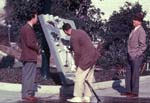 (EHDD Historic Photo) EHDD founder Joseph Esherick (center) outside Wurster Hall, University of California, Berkeley in the mid-1960s, using a model to study sun angles and shadows.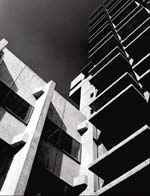 (Rondal Partridge) The design of UC Berkeley's Wurster Hall uses sunshading, daylighting and environmentally sensitive structural systems. Joe Esherick was on the team that designed the building in 1963. (Peter Dodge) At Sea Ranch on California's Sonoma coast, the concept of letting the site and environment shape buildings is reflected in the form of the early buildings, which respond to the cold and windy climate; houses reflect the sloping hedgerows.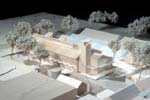 (Cesar Rubio) Global Ecology Center's cool tower provides passive cooling to the building's lobby, and serves as a marker to draw visitors into the courtyard. (EHDD) An outline of sustainable design strategies used at the Global Ecology Center. The building's long, thin footprint facing north and south offers ideal daylighting and cross-ventilation.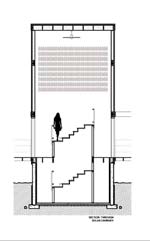 (EHDD) A cross-section of the Factor 10 House, seen through the central solar chimney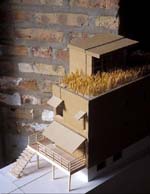 (EHDD) A model of the Factor 10 House highlighting the grass roof and south-facing clerestory window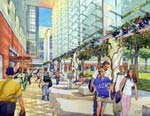 (Frank Costantino, Architectural Illustrator) UC Merced's Science and Engineering Building receives strong, direct solar gain at the southeast and southwest. To reduce energy use and create a more habitable exterior space, a large arcade with glass sunshades runs the length of these elevations.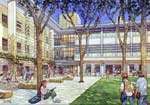 (Frank Costantino, Architectural Illustrator) A view of UC Merced's glass arcade (left) and the central stair at the elbow (center)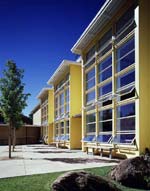 (David Wakely) The Ross School courtyard elevation has operable windows at high and low levels for good stack ventilation.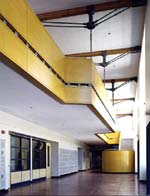 (David Wakely) Ross School's large sidelights bring balanced light into classrooms; exposed concrete floors contain radiant heating tubing and thermal mass for night ventilation cooling. (EHDD) An exterior screen wall modulates natural light in Valparaiso University's new Center for Information Resource. The wall provides solar control, reducing glare and direct solar gain. (EHDD) A cross-section of the Computer History Museum depicts the sloping grass roof that shields the building from solar gain and becomes an architectural feature visible from the freeway.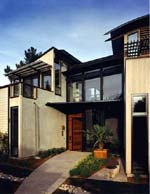 (David Wakely) This single-family residence in Palo Alto, California exemplifies environmentally sustainable architecture by integrating sustainable materials and systems, such as photovoltaic panels, grey water collection, cellulose insulation, and low-e glass. |
© 2003 ArchNewsNow.com